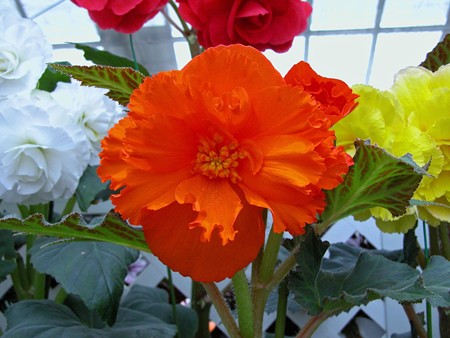Tuberous Begonias...Get Planting!
By Jos Van Hage

Tuberous begonias are a beautiful shade loving plant that will enhance any shady spot in the landscape throughout the summer months. They are most often grown by starting the tuber indoors around the month of February when the tubers become available in the garden center. There are many different varieties of begonia tubers that come in a wide range of color in either upright or hanging.
One of the nice things about starting your own tuberous begonias is that you have a much larger selection than you would if you wait till May when the plants become available in the garden center as the selection of plants is more limited to the basic varieties. Another bonus is the money saved by planting your own tubers, especially if you save your tubers from one year to the next which is done quite easily. Also, there is the satisfaction of watching and tending to your own plants as they start from just a tuber planted in a pot of soil to becoming a beautiful plant that can be enjoyed throughout the summer.
To start tuberous begonias first choose a tuber that is firm and large as the larger tubers will produce a larger plant and in turn more flowers. Next you want to plant the tuber in a light and airy, well drained potting soil. At the greenhouse we start all our begonias in peat pots as this will minimize any root damage to the plant when it comes time to transplant them later in the spring as you can plant the entire peat pot with the plant into a larger container or into the ground.
Fill the peat pots with the soil and then place the tuber with the hollow side up just below the soils surface so that there is ½ an inch of soil on top of the bulb. Next give the tuber a good water and always water the soil around the tuber and never directly in the hollow part of the tuber as this can cause it to rot. After the tuber has been planted and watered place it in a window sill or under a grow light where the temperature is 17-20 Celsius.
To quicken the growth place a plastic grower dome over the pot and when the growth appears (pink eyes) remove the dome from the pot. Only water the tuber if the soil becomes very dry or until the tuber starts to show signs of growth which is when you increase on the water. Depending on the tuber, some tubers will start to show signs of growth almost immediately while others may take 5-6 weeks but as soon as the tuber begins to grow it will grow quickly.
Once the tuber starts to grow you want to give it as much light as possible but avoid the direct midday sun as these are shade loving plants. Keep the soil moist, but not soggy and fertilize with 10-52-10 to promote good growth. After the plant has produced two equal sized leaves or is 3-4 inches tall it can be transplanted into a larger pot. To produce a strong, stocky plant, place the begonia in a cooler location and turn the plant every few days for even growth.
In late May after all risk of frost has passed the begonias are moved outdoors into a semi-shaded location where they will receive the early morning sun or early evening sun but kept away from the mid-day sun. Too much sun will cause the leaves to burn whereas too much shade will cause the plant to become spindly. Always water the plants in early morning trying not to get water on the plants foliage as this can cause mildew, so water the surrounding soil but the plants leaves. Fertilize weekly with 12-36-12 during the summer months.
To keep the plant looking healthy and happy, remove the finished flowers as they appear and any damaged foliage.
In September after the plant has been blackened by the first frost, gently dig up the tuber and set it on a newspaper and place it in a cool location for a couple of weeks. Next cut back the stems 4-6 inches from the tuber and gently remove any surplus soil trying not to disturb the tuber. After a few weeks the remaining dried up stem will fall off and the tuber can be sprinkled with bulb dust and be placed in a closed container filled with vermiculite or dry sand. Store it in a dry dark area where the temperature is 6-10 Celsius. Leave it there until February when you can replant it again
-Jos
Jos VanHage owns two Art Knapp Garden Centres in Prince George,
- Highway 16 West at Kimball Road
- HIghway 97 North at Northwood Pulpmill Road
Previous Story - Next Story
Return to Home









